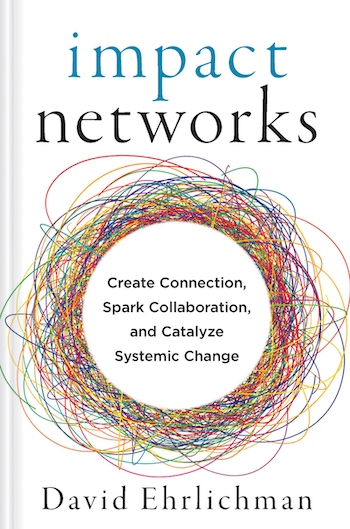David Ehrlichman's Blog
October 21, 2022
Fostering Self-Organization
An excerpt from Impact Networks on four key principles to realize the immense potential of collaborative and purpose-driven networks. Originally published in Stanford Social Innovation Review.
When working in collaboration with others, where there’s no single person in charge and the way forward is unclear, it can be hard to know when to lead and when to follow.
In these situations, you may hope that people spontaneously self-organize to get things done, but the reality is that leadership always m...
January 29, 2022
The Network Mindset: Scaling Out, Not Up
Once you begin to recognize the webs of relationships that make up our world, you will never go back. This is what we call the network mindset shift. To adopt a network mindset is to embrace the reality that everything is connected — that the actions of individuals, organizations, and sectors affect one another in profound and often-unexpected ways. The network mindset is, more than anything, characterized by “a way of looking at the world, a shift in perspective . . . to see it relationally,” C...
November 2, 2021
What Networks Can Learn From Flocks of Birds
Sometimes, the actions of what seems like an incredibly complex system can actually be explained by a few simple rules.
Consider the incredible murmurations of starlings, in which a group of dozens or even hundreds of birds swirl, shift direction, and move swiftly across the sky. The birds somehow seem to move both in unison yet also in unpredictable ways.
https://medium.com/media/01003aa0091ca670c3124f610384bd99/hrefAs it turns out, mathematical models have demonstrated that their cohesion is due...
October 12, 2021
Introducing Our New Book
Today is a special day! After four years of research and writing, today our book becomes available to the world: Impact Networks: Create Connection, Spark Collaboration, and Catalyze Systemic Change, written by David Ehrlichman and published by Berrett-Koehler Publishers. Find it wherever books are sold in print, as an audiobook, and as an ebook.

In this book we draw on our experiences as network builders; interviews with 40+ incredible network leaders; and insights from the fields of network sci...
September 24, 2021
The Web of Change
“We are caught in an inescapable network of mutuality, tied in a single garment of destiny. Whatever affects one directly, affects all indirectly.” — Martin Luther King Jr., Letter from a Birmingham Jail

The following post is excerpted from the introduction of Impact Networks: Create Connection, Spark Collaboration, and Catalyze Systemic Change , now available in print, as an audiobook, and as an ebook.
Since the beginning of our species, humans ha...
March 31, 2020
How to Cultivate Meaningful Online Gatherings
I met my sister Rebecca at the nearby beach about a week before the stay-at-home order was put in place here in Seattle. It was a chance to connect in-person, six-feet apart, with one of my favorite people, as well as an opportunity to hear how the University of Washington’s Evans School of Public Policy & Governance is adjusting to its quick switch to an online reality.
With all in-person instruction cancelled, faculty who were previously reluctant to pu...
March 27, 2020
Tech Tools for Impact Networks
Updated March 31, 2021
Most impact networks will benefit from an assortment of simple and effective software tools for tasks such as written communication, audio and video conferencing, polling and group decision-making, ideating and whiteboarding, collaborative document and spreadsheet creation, file sharing, and scheduling, as well as asset mapping and social network analysis.
The right set of tools can drastically amplify the network’s ability to stay connected and self-organize. Choose the wro...
March 15, 2018
Cutting Through the Complexity: A Roadmap for Effective Collaboration
Collaborations and networks rarely achieve their ambitious goals. Here’s what it takes to make them actually work.
By David Ehrlichman, David Sawyer, and Matthew Spence

Collaboration is appealing in concept but challenging in practice. While extensive resources — including ones from the Community Tool Box, The Intersector Project, and NewNetworkLeader.org — exist online to support collaborative efforts, the fact remains that we human beings are simply not very good at making “we” work. And yet, mo...
Asking the Right Questions: Collecting Meaningful Data About Your Network
David Ehrlichman & Matthew Spence, Converge ( converge.net )
The effectiveness of any collaborative effort — whether it’s a network or an organization — depends primarily on the strength of the connections that exist between the participants involved. Social network analysis (SNA), using mapping tools like Gephi or Kumu, is the most effective method currently available for visualizing that connectivity and for evaluating a collaboration’s effectiveness. However, SNA is only useful if it is construc...
March 8, 2018
Identifying Leverage Points in a System
Incredible things can happen when the right group of people are focused on a shared purpose, when they trust each other, and when they seek out opportunities to support each other’s work. For true systems change to occur, however, collaborations must identify and act on opportunities to affect the whole system.
Doing so requires zooming out to grasp the big picture, and seeing the forest for the trees. It requires that participants address the root causes of problems, rather than just mitigate th...



